Rosso Fiorentino's Deposition: a chilling hallucination
One of the most beautiful, most evocative and most famous descriptions of Rosso Fiorentino’s Deposition, the masterpiece by Giovanni Battista di Jacopo (Florence, 1494 - Fontainebleau, 1540) kept at the Pinacoteca Civica in Volterra, can be read between the pages of Gabriele D’Annunzio’s Forse che sì forse che no. Aldo and Vana, two protagonists of D’Annunzio’s novel, have entered Volterra’s Palazzo dei Priori, where the collection was set up in 1905, before it was later moved to its present location in 1981 at Palazzo Minucci-Solaini. They linger in front of the large altarpiece, Vana taking a few steps, closing her eyes and reopening them before the Deposition to consider its “mute tragedy,” her brother inviting her instead to listen to its sounds, the cry of Magdalene, the sobbing of St. John. “Truly the red robe of the woman prone at the knees of the Holy Mother was like the cry of passion still tumid with turbid blood. The interrupted flutters of light on the Disciple’s yellowish cloak were like the sobs of the beaten soul. The men on the steps were as if caught in the violence of a fatal wind. The force stirred in their muscles like an anguish. In that body, which they drew down from the cross, weighed the price of the world. In vain Joseph of Arimathea had bought the shroud, in vain Nicodemus had brought the mixture of myrrh and aloes. Already the wind of resurrection was blowing around the sublime wood. But all the shadow was down, all the sepulchral shadow was over one flesh, it was over the darkened Mother, over the womb that had borne the fruit of sorrow.”
Rosso Fiorentino’s painting has always enjoyed good fortune with critics. Already Vasari, in the first edition of the Lives, wrote that Rosso “in Volterra painted a beautiful Deposition of the Cross.” Almost identical words those of Raffaello Borghini’s Rest, where we read that the artist “in Volterra painted a beautiful Deposto di croce.” In the eighteenth-century Series of Men the Most Illustrious in Painting, Sculpture, and Architecture, the “marvelous Deposition of Jesus Christ from the Cross” is mentioned. Of course, contemporary praise is not counted, as well as tributes, starting with the celebrated one that Pier Paolo Pasolini rendered to the painting in La ricotta, recreating it as a tableau vivant along with Pontormo’sDeposition. It is, in fact, one of the capital works of the sixteenth century, among the most poetic, metaphysical, dramatic and unprejudiced of the century, as well as, if we wish to attach a label to the work, one of the masterpieces from which the Mannerist season began.
The panel was commissioned from Rosso by the Compagnia della Croce di Giorno of Volterra, and the artist painted it in 1521: from then on, it remained on display in the chapel of the compagnia, attached to the church of San Francesco, until 1788, when it was moved to the chapel of San Carlo inside the cathedral after the work and the chapel were purchased by the Guidi counts, who profited from the laws that, starting in 1785, made ecclesiastical suppressions begin in the Grand Duchy of Tuscany. Later, in 1905, with the setting up of the Pinacoteca Civica, the work was immediately transferred there, and since then its history has remained linked to that of the museum. Indeed: it could be said that Rosso Fiorentino’s Deposition is almost the image of the Volterra art gallery, the main reason people visit, often even the reason they go to Volterra.

For the art of the time this was a completely unprecedented image: a vivid and violent drama, an alienating tragedy, characters more like ghosts than people, a physically impossible composition, total and absolute negation of Renaissance balance and harmony. A “tangled and bizarre” tableau, as André Chastel would have called it. Or again “a chilling hallucination,” if we want to refer to the expression, perhaps even more effective, coined by Evelina Borea. Dominating the compositional scheme of the work is the cross of Christ, which occupies the entire large vertically centered panel: the concrete and symbolic fulcrum of the scene, around the very tall wood of Jesus the entire story unravels. Christ’s body, painted a cadaverous green, is taken under the arms and below the knees by two characters who have climbed the two ladders resting on the horizontal arm of the cross, one on each side, one in front and one behind. Of the figure on the right, dressed in a blue tunic held tightly by a band of a soft orange, we do not see his head, hidden behind the arm of the cross. The other one, the half-naked one, on the other hand, is caught in an unrealistic position, as, turned on his back, he holds Jesus by the knees while remaining balanced on the pegs of the cross with only his right foot, and the whole weight of his body shifted toward the son of God: in reality he could not hold on and would fall after a second. Above, Joseph of Arimathea and Nicodemus are giving instructions to the two men: Joseph of Arimathea is shouting with one arm outstretched, his beard blending with the fur he wears on his back giving him an almost bestial appearance, the wind swells his cloak drawing a circular scroll over his back. Above again, Nicodemus appears to us as a creepy old man, skeletal, who also leans out screaming and holding onto the cross with his long arms: his proportions are made all the more unsettling by the effect of the scale that has almost the same hues as his left arm: it thus appears, from a distance, that Nicodemus leans in symmetry with two very long arms on the horizontal arm of the cross.
If the upper portion of the painting is that of force, impetus, violence, and shouting, the lower portion is that of despair, weeping, and silence. The Virgin, set against the light, is there to faint, supported by the pious women in the shadows, with Magdalene hugging her knees, almost throwing herself at her feet, her blond hair gathered and her red robe iridescent. On the opposite side of the cross, a young man is holding up a third ladder, resting unclear where. On the right, Saint John turns away as if to leave the scene: we do not see his face since, distraught, he is holding it in his hands, wracked with grief. We have wanted to recognize in the figure of the beloved disciple, also dressed in a cloak of iridescent ebony hues, a self-portrait of Rosso Fiorentino: the hair is the color that earned him his nickname, and the young age of Saint John is compatible with that of Rosso, since at the time the artist was twenty-five. There are no matches, however. In the background is a sky of a deep blue that must have measured up to the hues that, a century earlier, Cenni di Francesco had used for the frescoes of the Chapel of the Cross in Giorno. In the distance we notice the outline of the hills, and near the right edge a group of characters wander through a desolate land, where not a single plant grows, where no towns or villages can be glimpsed, where everything is deserted. Finally, on the foot of the third staircase, the one placed across, Rosso dated and signed the work, with his nickname: “RUBEUS FLOR. A.S. MDXXI.”
With the Deposition, Rosso Fiorentino had gone even further than the obvious anti-classicism he had poured into the Spedalingo Altarpiece, now in the Uffizi, painted three years earlier: what Rosso was demonstrating in the Volterra altarpiece was first and foremost, Andrea Baldinotti has written, a “decisive move toward a poetics that was capable of lowering his gaze, which had always been directed toward the great masters of the Florentine tradition of the early Renaissance, within a formal envelope in which the abstract qualities of colors and of the scenic layout could play a leading role.” Wanting to look for the main novelties in Rosso Fiorentino’s image, one could point first of all to the highly scenographic direction of his composition, set on the interweaving of the cross with the stairs, capable of providing a structure at once solid and immaterial, an almost abstract layout that suggests to the viewer an initial feeling of alienation. This feeling is then amplified by Rosso Fiorentino’s use of color and light. The colors: there is, meanwhile, that of the sky, a compact blue that the artist uses, as Mariagiulia Burresi and Antonino Caleca have noted, “as an instrument for the construction of space” to reveal “the close connection of all the means of expression employed by the artist for the realization of this complex scenic machine.” A twilight sky, within which the vanishing point of perspective is lost, right at the point of maximum luminosity, behind the foot of the cross, and from which “the entire spatial construction departs, rigorously determined by the directrices of the rungs of the ladder, depicted in foreshortening on the right, and by the two groups of the mourners, below, who sink to the sides of the cross from the very foreground towards the horizon.” Then there are the iridescences and the juxtapositions of complementary tones, used by Rosso with a certain insistence and even with a certain violence to increase the visionary aspect of the scene, and then again the unreal tones used “with irrationality that comes to unravel in strange deformations and in unlikely iridescences the final group always chiaroscuro,” Mario Salmi had to write, “while sound notes of color invested with abstract light dominate in the lower part.”
Light, indeed: a cold, almost metallic light that interferes with the forms and contributes sculptural evidence to the figures (by means, above all, of their robes, which appear almost faceted). Scholar Linda Caron, in her 1988 essay, has well pointed out the modernity of the Deposition’s light: although “it is consistent in direction and intensity, it is nonetheless anomalous in sharpness and lightness. Rosso still uses light as a pretext for abrupt transitions in the saturations of hues and the faceting of forms; instead of modeling his forms in chiaroscuro, as Leonardo or Friar Bartholomew did, and thus employing a gradual change between light and shadow, Rosso introduced such a sharp color break between full light and shadow as to create almost an additional contour, particularly evident on the Magdalene at the foot of the cross. The forms begin to lose their illusion of three-dimensionality, to be dissolved by color and light, which together work to fragment and flatten them. Such manipulation of color and light is consistent with the aesthetics of the developing Mannerism: the earlier goal of the mature Renaissance of creating the illusion of consistently round forms in continuous space was replaced by the desire to create a work of art that emphasized the artificial.” Not least, the figures themselves, with their angular, grizzled faces in the upper part, their features concealed by shadow in the lower register, their robes moved by a stormy wind that makes nature a participant in Christ’s drama: the figures all end up making the viewer uncomfortable.
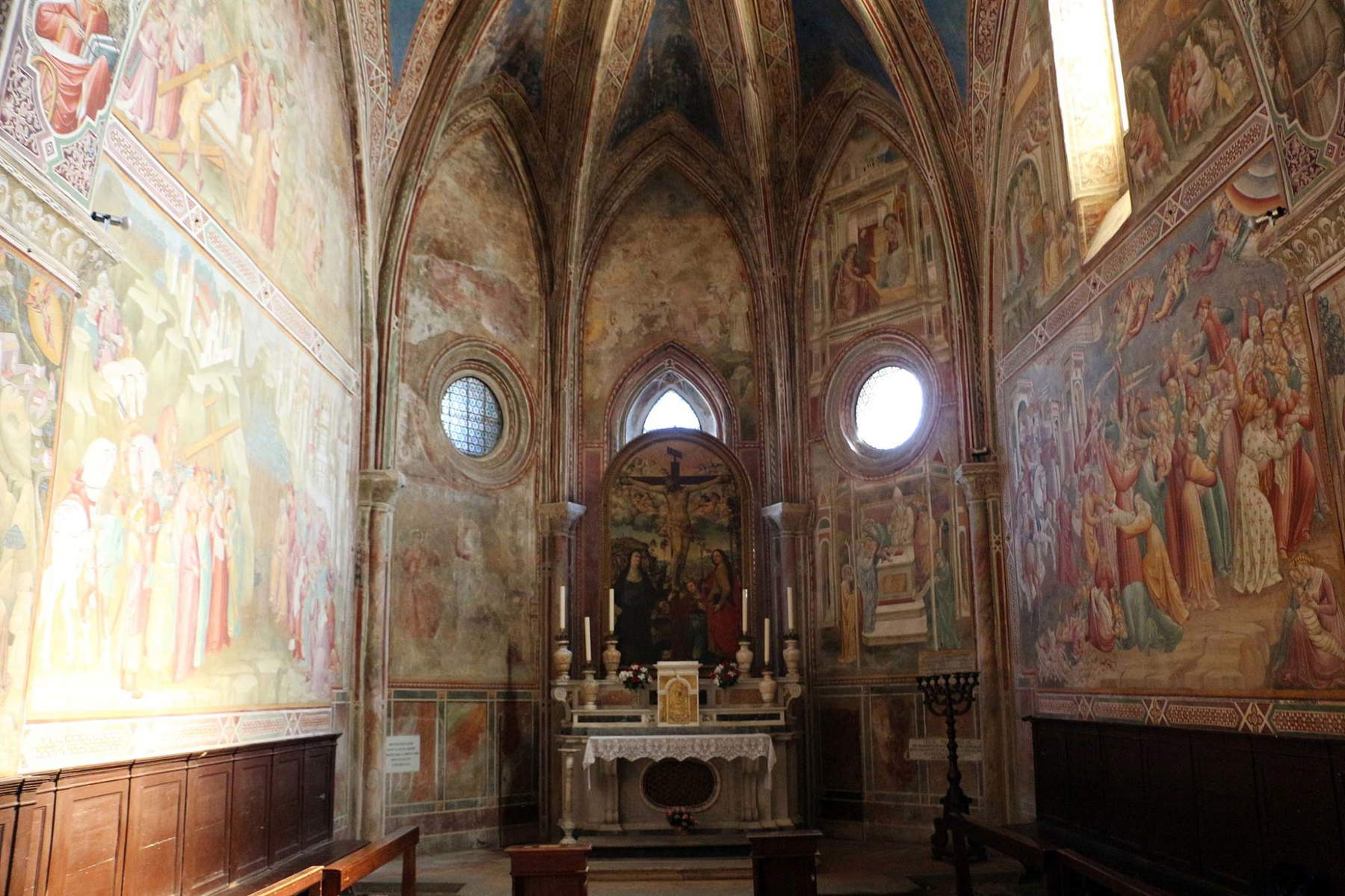
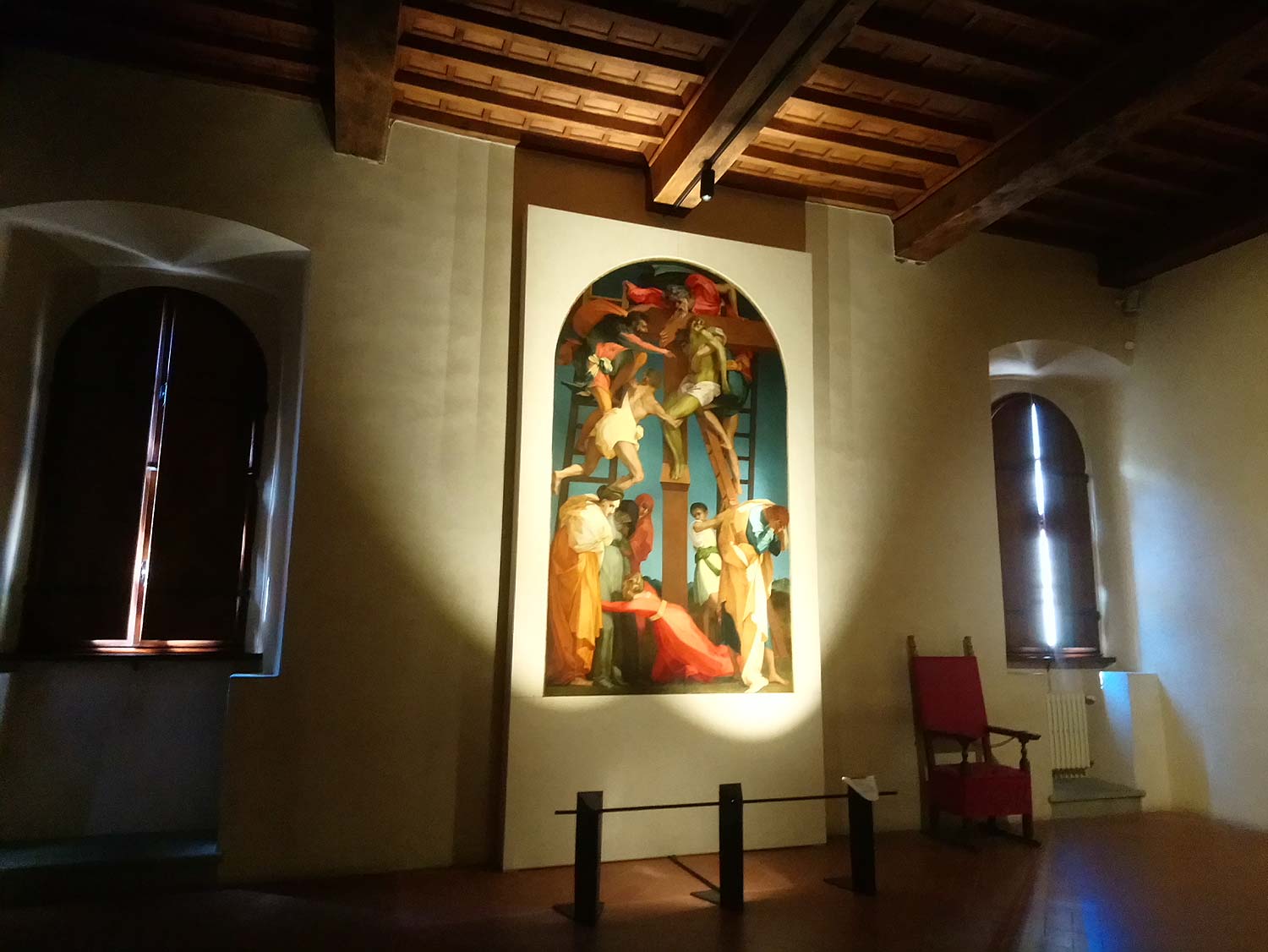
Where did this impetuosity come from, where do these formal innovations that give substance even allegorically to the anxieties of a turbulent historical era? Much has been written about the figurative sources of Rosso Fiorentino’s Deposition. Already the aforementioned Mario Salmi saw in the Deposition for the Santissima Annunziata in Florence, a work begun by Filippino Lippi and finished by Perugino, the most direct antecedent direct antecedent of Rosso’s Deposition, substantially because of the similar compositional structure and some formal solutions to which Giovanni Battista di Jacopo seems to look with some interest, first of all the idea of setting the whole scene around a cross that occupies the composition vertically, from the lower to the upper edge, making sure, moreover, that the head of the cross is not seen (in fact, it will be noted that in both Rosso’s and Filippino’s and Perugino’s Deposition, the Titulus crucis is not seen). Even the precariously balanced figure on the right in the Annunziata altarpiece and on the left in the Volterrana altarpiece appears quite similar, although Rosso’s profound originality and the subversive and irrational character of his altarpiece devastate the credibility of Filippino’s and Rosso’s figures to offer to the eyes of the faithful a man who remains standing on the ladder but it is not known how. Otherwise, however, it is a work with a profoundly and radically different soul from that of Filippino Lippi and Perugino, who, moreover, took over from his colleague and resorted to extensive workshop help, since the faces of the characters appear repetitive, almost stereotyped.
Assonances with Michelangelo’s art have also been observed: the man in the yellow knickers on the left reworks one of the nudes in Buonarroti’s Battle of Cascina; the Christ recalls that of the Vatican Pietà; the same proportions of the bodies, vigorous and massive, have been juxtaposed with those of the figures in the Sistine Chapel vault. And again, Rosso’s plasticism has also been related to that of the Masaccio. Recently the hypothesis has taken hold that the Volterra Deposition preserves some echoes of the Neapolitan sojourn of Rosso Fiorentino, who in 1519, after staying for some time in Piombino, at the court of Jacopo V Appiani for whom he is said to have painted, according to Vasari, a “beautiful dead Christ” and a “little chapel” of which we have no trace today, left probably to Naples, a city whose court had deep ties with that of the Appiani, and where the artist would have remained perhaps as long as a year or more, until the date of his arrival in Volterra in 1521. Carlo Falciani and Antonio Natali have suggested that the formal roots of the Volterra Deposition should be identified in the frescoes of San Domenico Maggiore and the marble decorations of the churches of San Giovanni a Carbonara and Santi Severino e Sossio. The angular, wind-whipped robes echo those that Diego de Siloé and Bartolomé Ordoñez carved in the altar of the Epiphany in San Giovanni a Carbonara, a masterpiece preserved in the Caracciolo chapel in Vico that predates the Volterra Deposition by a few years (it dates from around 1521); the angular faces of the upper part recall those that Pedro Fernández painted in the Carafa chapel in San Domenico Maggiore around 1508, or his San Biagio now in the Museu nacional d’art de Catalunya in Barcelona but once in Naples, to the dramatic Deposition decorating the base of Andrea Bonifacio’s tomb, attributed to Bartolomé Ordoñez and preserved in the church of Saints Severino and Sossio, which as to intensity of pathos might be one of the most interesting references for Rosso’s altarpiece.
Then there were other homages and references: again Carlo Falciani, for example, related Rosso Fiorentino’s characters to those, resolved in equally harsh lines, that Donatello executed on the bronze doors of the Sacristy of San Lorenzo in Florence, without forgetting then the gesturality of the characters of the same Cenni di Francesco in the frescoes of the Chapel of the Cross in Giorno: Rosso’s Magdalene, for example, is in a pose identical to that of the woman in yellow who appears in the Strage degli innocenti fresco on the chapel. There has also been no shortage of approaches to Albrecht Dürer, who may have been a reference for Rosso just as he may have been for Pontormo’s Deposition.
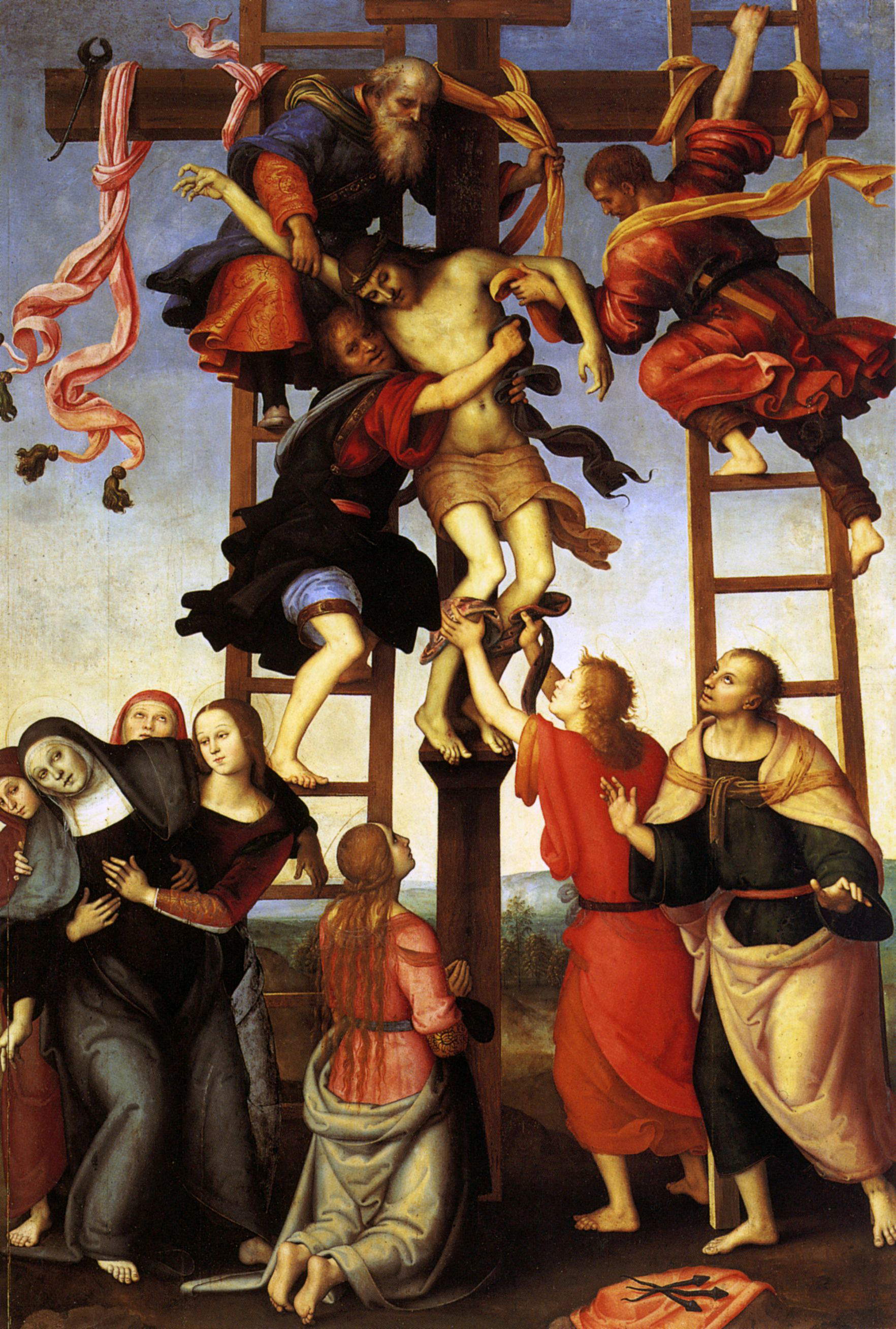
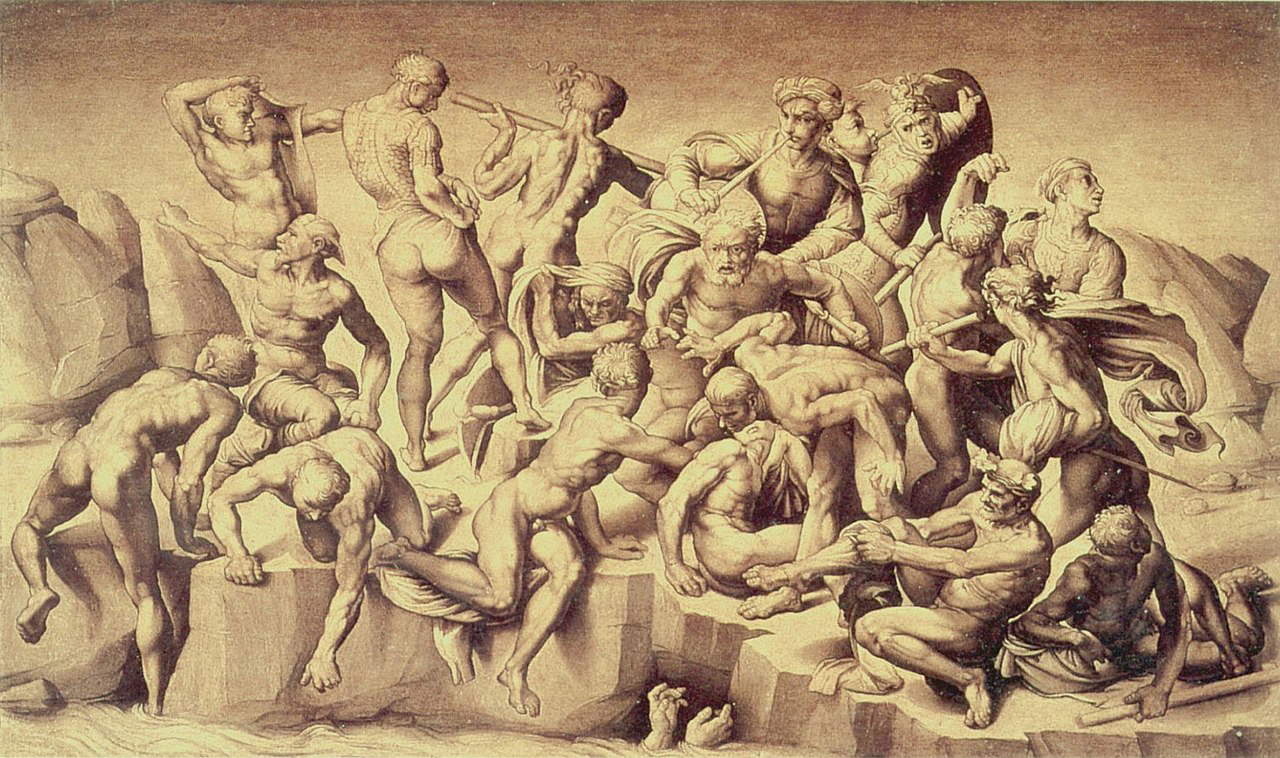

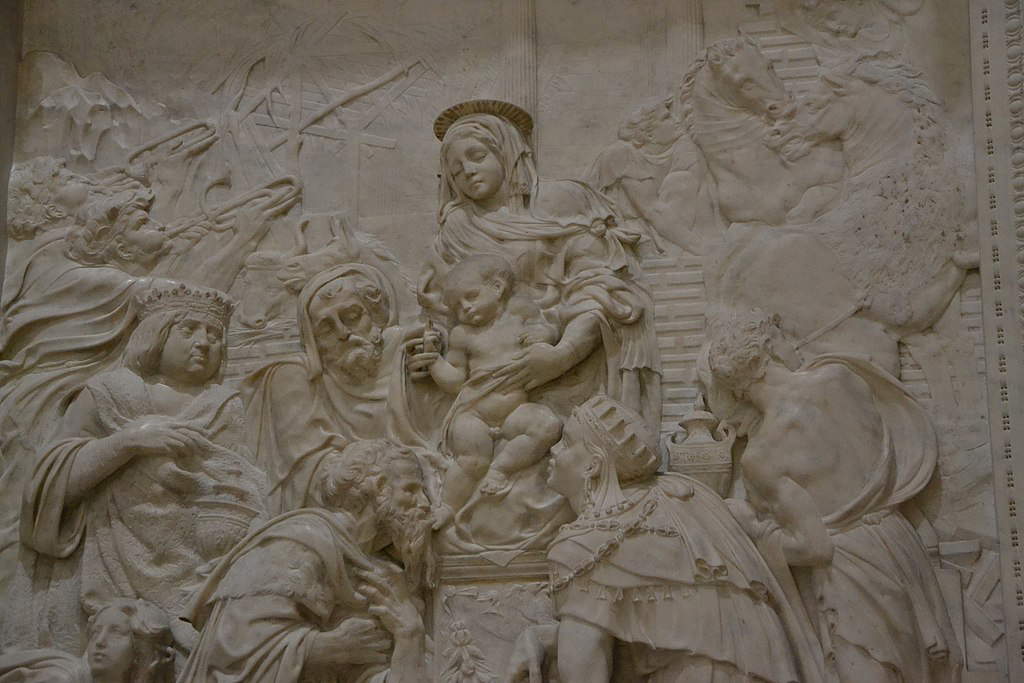
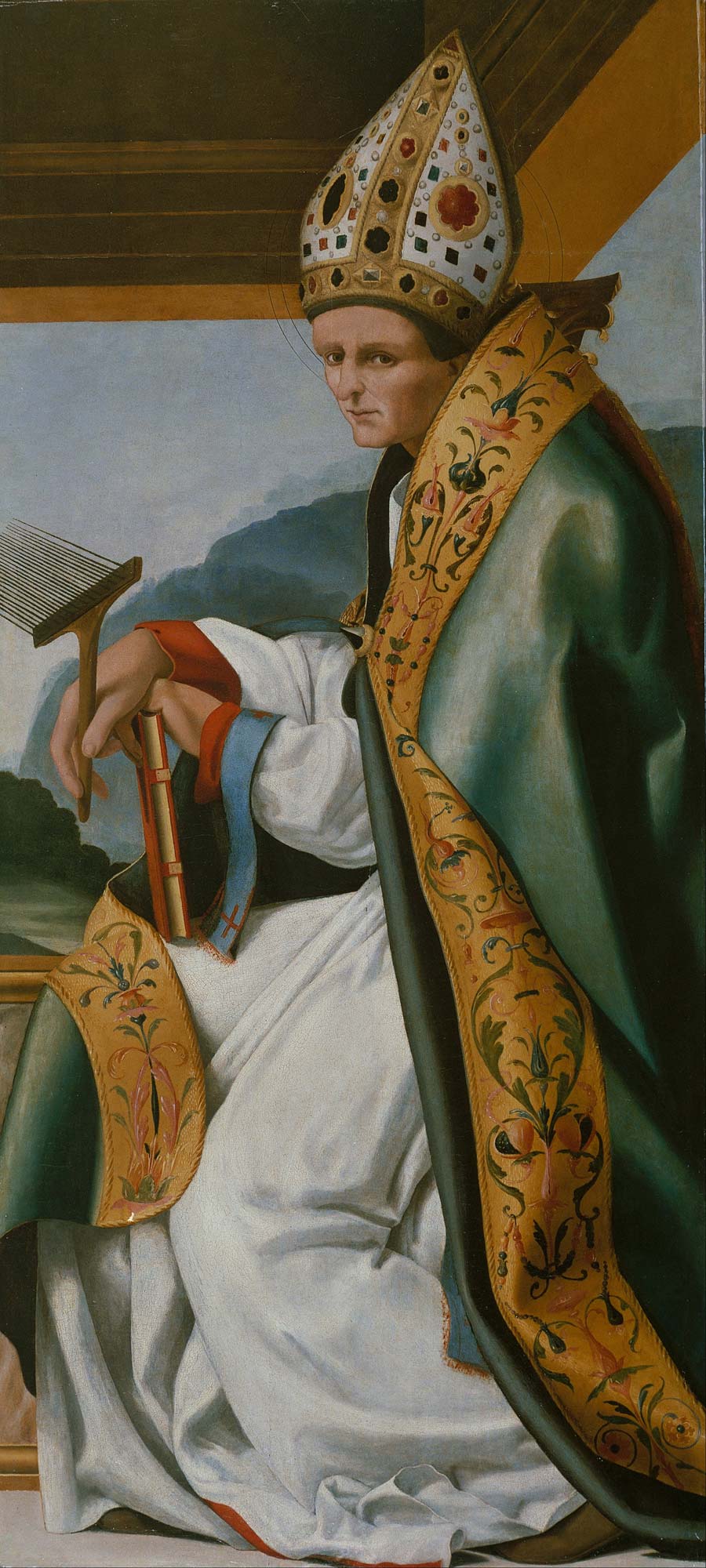

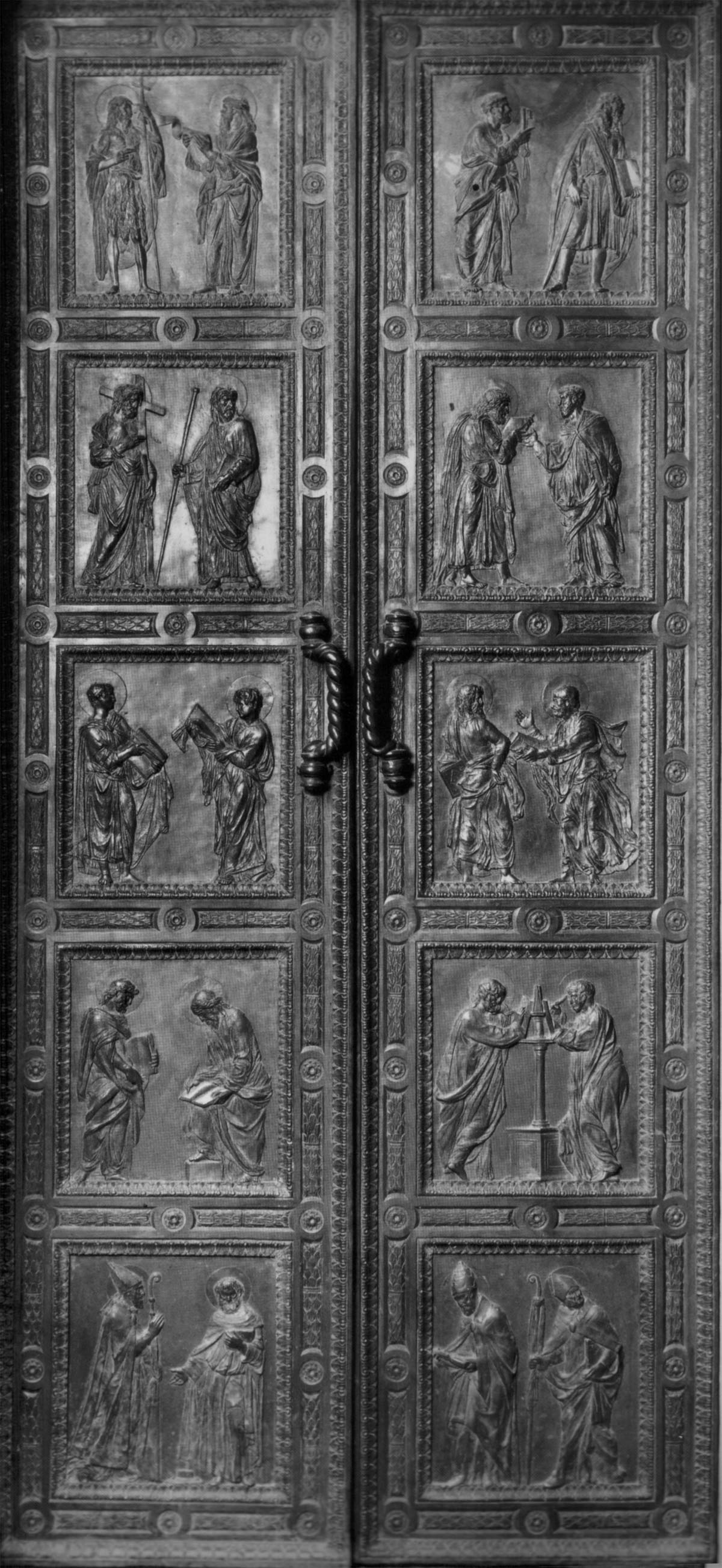
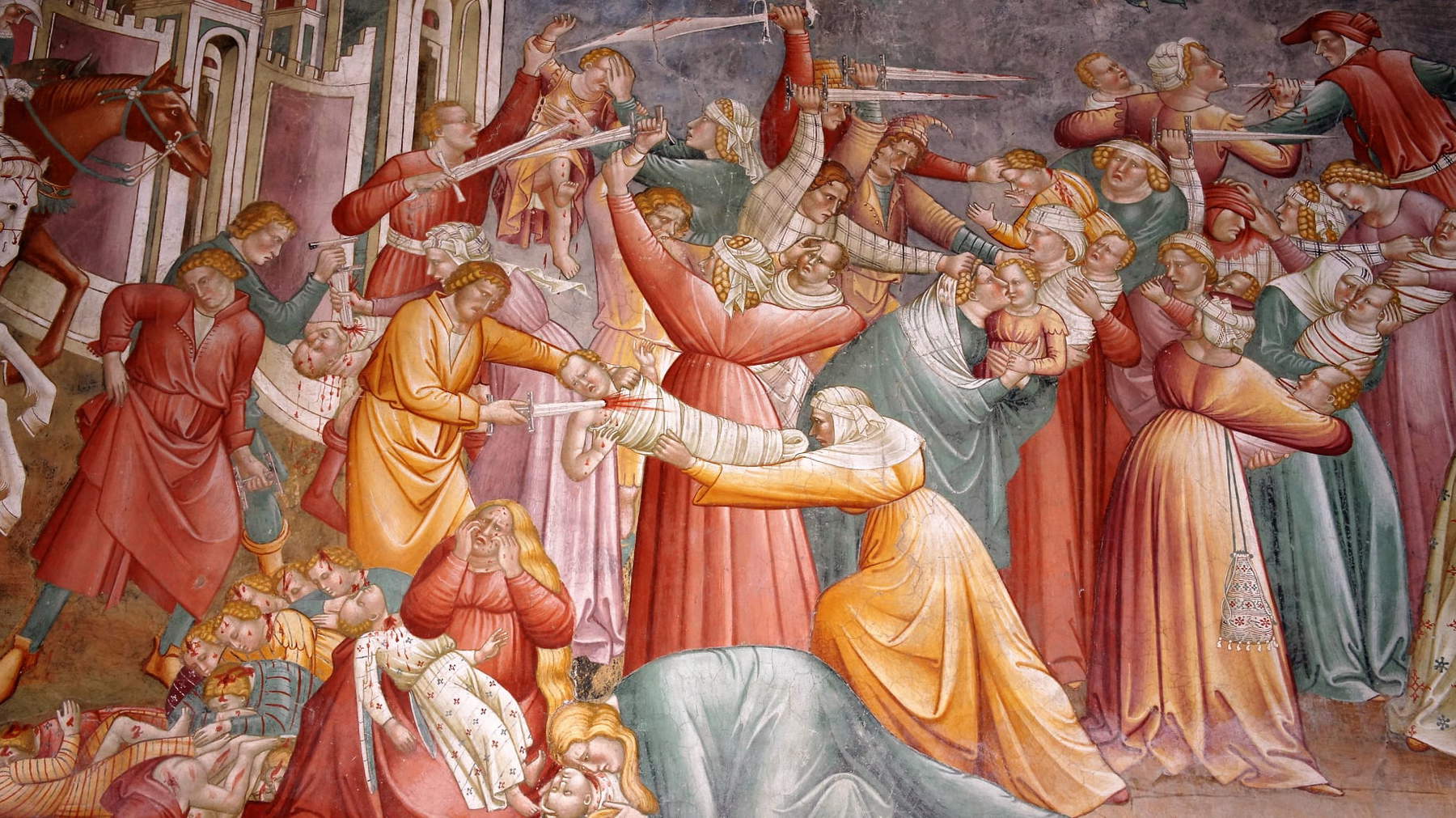
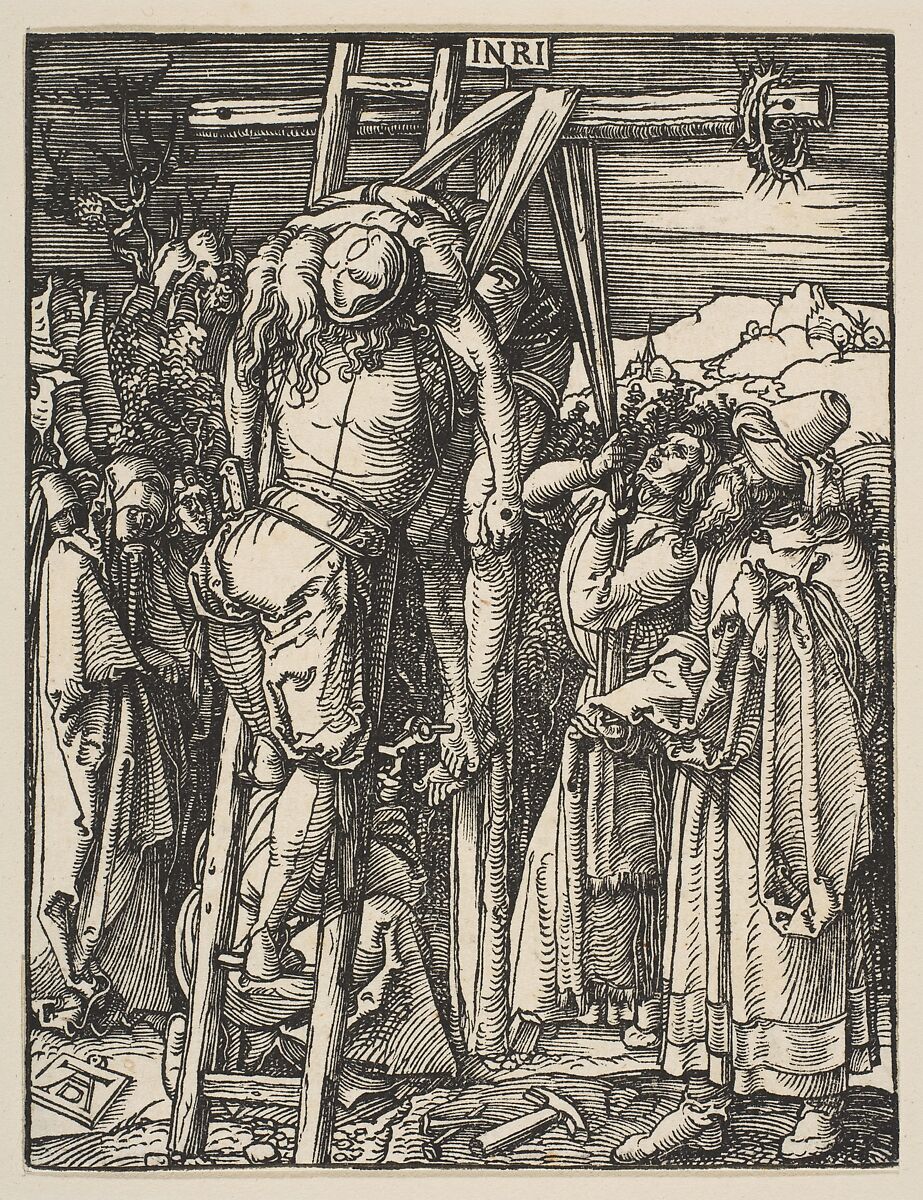
We speak, however, of precedents reworked by that “wise poetic logic” and above all that “abstract imagination” which, as Paola Barocchi has well pointed out, regularly informed Dürer’s inventions. And it is precisely the Deposition, Barocchi suggested, that is the painting that best accounts for these qualities of the artist, and it is the work in which Rosso’s “stylistic torment” “arrives, through ever new suggestions and affirmations, at a very high creation.” A stylistic torment, which, according to some, was nevertheless also spiritual torment: it has often been written about how Rosso Fiorentino might have been moved by the memory of Savonarola’s preaching (although, for reasons of age, they could not make a direct impression on the artist, who was barely a child when the Ferrarese friar inflamed the Florentine people with his flaming sermons), who with his mystical thought might have informed the painter’s restless spiritual horizon. And it may also be this proximity of his to Savonarolian mysticism that is one of the reasons why the Medici never named Rosso Fiorentino, for any of their works, as opposed to Pontormo, Rosso’s “different twin,” who instead frequented the ruling family with some regularity. From Pontormo, then, separated him an almost opposite character: introverted, melancholy and solitary Jacopo Carucci, stormy and impetuous Giovanni Battista di Jacopo. Yet both have many points in common: born in the same year, both pupils of Andrea del Sarto, both eccentric and nonconformist, both capable of initiating a language that brought major upheavals to the art of their age. However, many are the differences that separate them, and that also divide their two masterpieces, often compared, and on one occasion exhibited together, during the major exhibition on the Florentine sixteenth century at Palazzo Strozzi in 2017-2018.
According to Arnold Hauser, Pontormo did not appear as “striking, whimsical, and challenging” as compared to his peer because, “while his art is certainly no less spiritualized nor less introspective, in him the intellectual and emotional tension never reaches a feverish intensity, nor does his expressionism ever have the moving dramatic force that distinguishes Rosso’s art at this point in its evolution.” In fact, Pontormo’s tension, no less than Rosso’s, though unable to emerge with the same expressionistic intonations as Giovanni Battista’s, can be said to reveal itself with some differences in language. Common to both artists is the disarticulation of space (even, in this respect, Pontormo appears even more extreme than Rosso, since in the Deposition of Santa Felicita all spatial references are lacking, still present instead in Rosso’s painting, painted four to five years earlier than Jacopo Carucci’s), both create two altarpieces governed by a strong irrational feeling and where the absence of realism dominates, both are moved by the will to break the balances while not completely renouncing the tradition that, conversely, still provides them both with a repertoire of images and models that cannot be renounced (Michelangelo’s importance for Rosso has been mentioned, think of Raphael’s for Pontormo), both tend to construct their compositional scheme by pivoting it, as Hauser himself noted, “on a decorative system of coordinates, dominated by parallelisms and consonances.” see, for example, the serpentine lines on which the characters are arranged.
The dissent that innervated their works was thus equally alive and burning, and yet, while showing some points of convergence at the same time it expressed itself according to different visions. Rosso’s work, wrote Carlo Bertelli, is a “complex scenic machine [...] all shots, angles, corners, points, paginated on a single plane to give prominence to the darting motions of the figures in contrast to the abstract geometry of the stairs and the cross,” it is a painting that aims at the “astonishing effect,” working on the proportions of the characters with the hand of the sculptor and on the expressions accentuating the grimaces until they become almost animalistic. Rosso’s, while sharing Pontormo’s intellectualizations, is a decidedly more violent anti-naturalism than that of his colleague, who aims instead to engage the relative with more sophisticated play, with a denial of reality by means of a group of delicate, ethereal characters who on the one hand arrange themselves in poses contrary to the laws of physics, and on the other seem to lose their corporeity, according to an abstract style that moreover erases any spatial or temporal reference in order to give the drama of the Passion an eternal dimension.
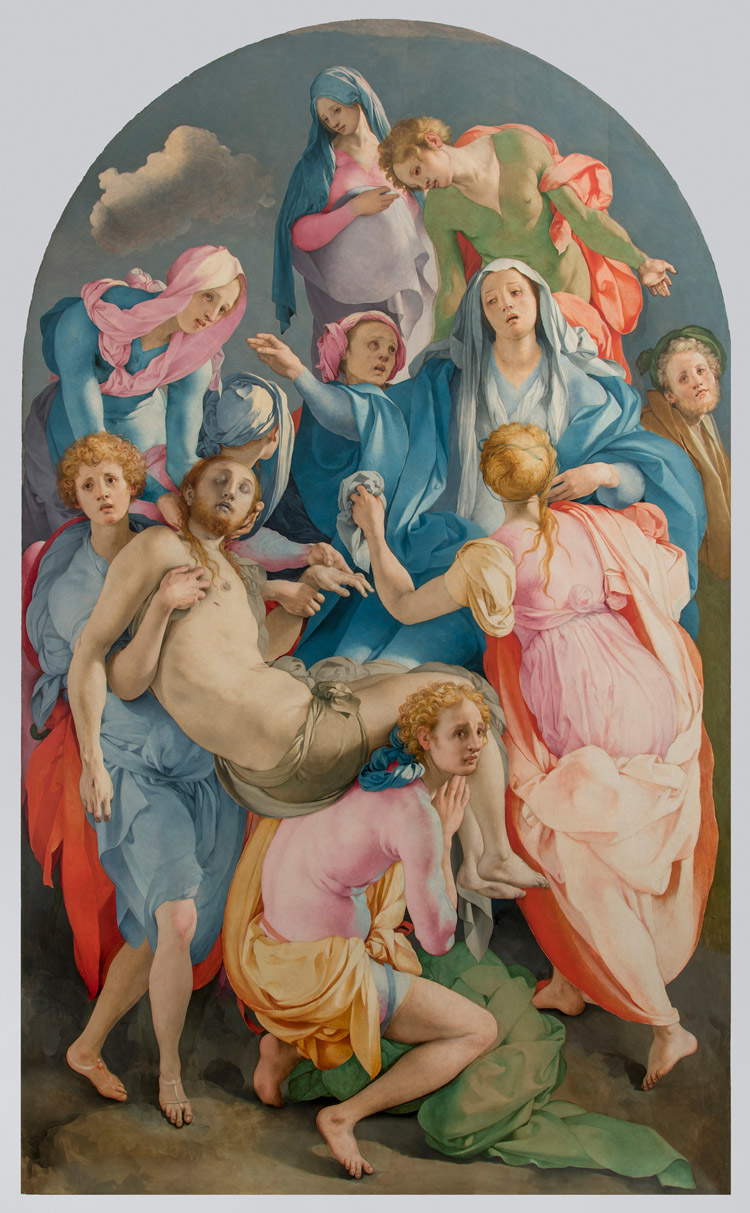
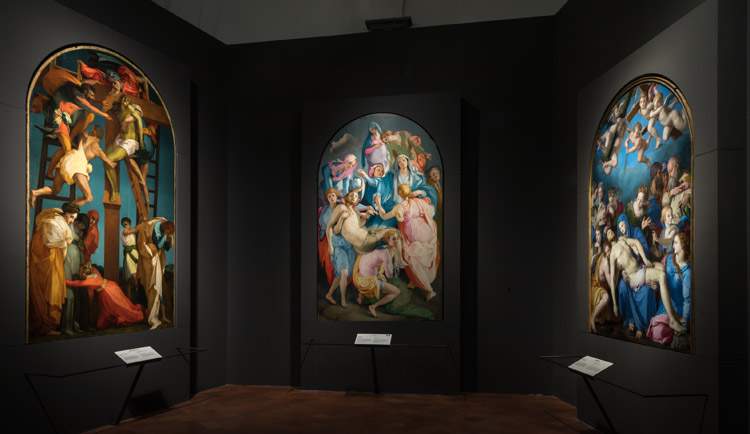
Although capable of achieving, as noted at the outset, a fair amount of success, Rosso Fiorentino’s Deposition would nonetheless leave a witness destined not to be picked up by later generations, who, as Baldinotti has written, “would only look at Rosso’s masterpiece from afar,” “through the filter of a painting that, though splendid in the richness of its tones and figurativefigurative layout, would gradually bend to the needs of the refined courtly world that had in Giorgio Vasari its mentor and its amphitryon.” According to the scholar, only a few artists of the next generation, including Mirabello Cavalori and Maso da San Friano, two of the actually most extravagant painters of the Florence of the second half of the 16th century, not to mention a whimsical painter like Carlo Portelli, would have recovered some of the inventions of Rosso, who already in life was forced to wander from city to city in search of commissions, eventually ending his days in France, in Fontainebleau, where instead the echo of his innovations remained most lasting. Only in the 20th century would the original character of Rosso’s Deposition be fully recognized, only centuries later would one see, in the extremism of that bold invention, the beginning of a new epoch, the start of a poetics that stood in dialectical relationship with all that had preceded it, without, however, denying the past, but rather demonstrating toward tradition a sincere and yet convulsive and frenzied transport.
Not even Rosso himself, in the later part of his career, would repeat himself with the same sharp fury as in the Volterra Deposition: already in the works of the Florentine period of 1522-1524 the modeling appears more delicate, and the light, however solid, does not have the same sculptural connotations as in the Volterra masterpiece. The painter would then return to the same iconographic subject just six years later with the Deposition of Sansepolcro, also an original work but still very different from the one painted for the Chapel of the Cross in Giorno. With that disruptive work of his, Rosso had already marked an era.
Warning: the translation into English of the original Italian article was created using automatic tools. We undertake to review all articles, but we do not guarantee the total absence of inaccuracies in the translation due to the program. You can find the original by clicking on the ITA button. If you find any mistake,please contact us.




























